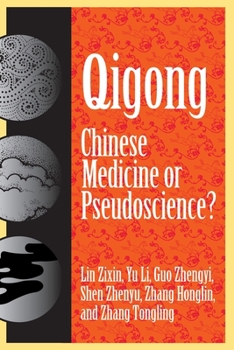Qigong: Chinese Medicine or Pseudoscinece?
Select Format
Select Condition 
Book Overview
No Marketing Blurb This description may be from another edition of this product.
Format:Hardcover
Language:English
ISBN:1573922323
ISBN13:9781573922326
Release Date:November 1998
Publisher:Prometheus Books
Length:155 Pages
Weight:1.10 lbs.
Dimensions:0.7" x 6.3" x 9.3"
Customer Reviews
1 rating
an opinion from the National Institute of Standards and Technology
Published by Thriftbooks.com User , 15 years ago
The credentials of the authors lend tremendous credibility: Lin Zixin, a former editor-in-chief of China's Science and Technology; Yu Li, a popular debunker of pseudoscience with the Chinese Ministry of Internal Trade; Guo Zhengyi, deputy director and Shen Zhenyu, research director of China's Popular Science Institute; Zhang Honglin, director of the Qigong research department of China's Academy of Traditional Medicine; and Zhang Tongling, professor of psychiatry at Beijing Medical University. The book comes with an introduction about the important place that Qigong held in the evolution of Chinese civilization and in the psyche of Chinese society. A brief history of Qigong and its relation to traditional Chinese medicine is followed by the author's definition of Qigong and its practice. To prepare the readers for the subsequent debate on quackery and Qigong, the authors detail how Qigong is practiced with 30 pages of text and 23 illustrations. The authors maintain that all Qigong practices can be summarized into three principles: regulating the body by practicing form; regulating breath to cultivate "Qi" or energy; and regulating the mind by practicing concentration. As such, the authors believe that the effect of Qigong is personal, and the essential nature of Qigong is a course of adjusting mental and psychological activity. All other claims of Qigong are either a misrepresentation of the facts or complete quackery. The goal of the book is to expose the falsehood of the pseudo-Qigong and quackery. There are numerous self-proclaimed masters of special types of Qigong who can break tombstones with their head (Tough Qigong), eat burning charcoal, stand on balloons (Light Qigong or weightlessness), etc. Some of these performances resemble those of magicians or "psychics" in the West. Reading how these tricks are exposed one by one is quite an enlightening and entertaining experience. The authors' experiments and discussion on External Qigong typifies the care they took in conducting the tests. External Qigong refers to the fact that some Qigong masters claim that they can treat patients with what is claimed to be Qi emitted by the master. The authors' explanation of such effects is psychological suggestion. They demonstrated this by severing lines of communication by blindfolding the patient to prevent him from seeing when Qigong is performed. When this is done, the effect of External Qigong disappears. They also showed that therapeutic effects similar to those of Qigong can be achieved by psychological suggestion. The authors are obviously very knowledgeable in Qigong, traditional Chinese medicine and related subjects such as human extraordinary abilities. In general, the authors take an objective stand towards the subject of investigation. Good experimental design and reproducibility are emphasized in their evaluation of the evidence. Numerous experiments supporting the presence of External Qigong are scrutinized and dismissed based on either






